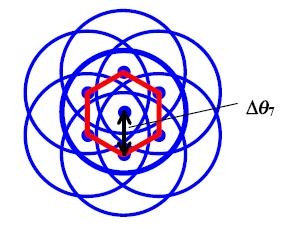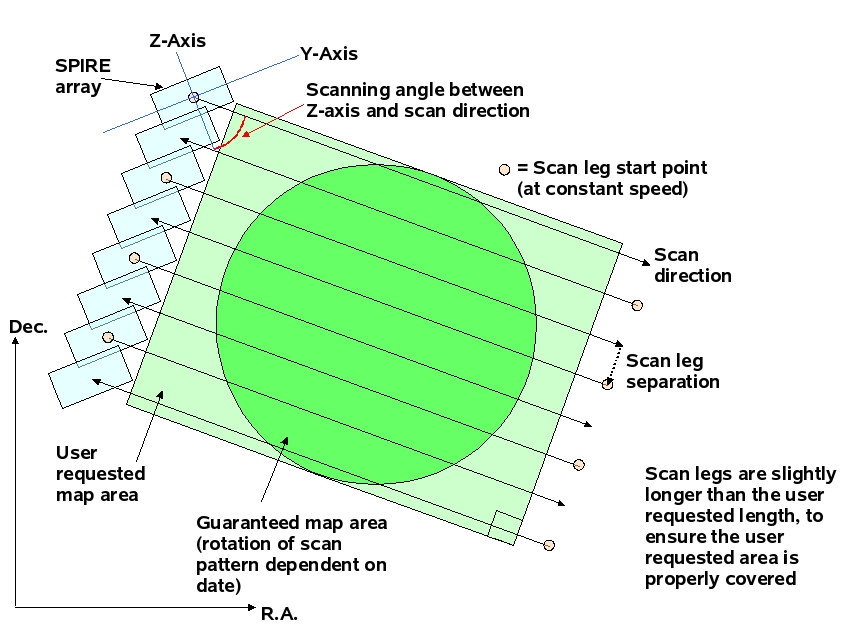SPIRE provides 3 observing modes for the Photometer (Point Source, Small and Large Map) and 24 for the Spectrometer (as a results of combinations of available spectral resolution, pointing mode and image sampling). Every observing mode is linked to an Astronomical Observation Template (AOT), which includes necessary information for planning an observation.
|
SPIRE supplies several photometer observing modes:
All the modes are described in detail following and the principal characteristics of the photometer are introduced in the table.
|
|

The 7-point jiggle pattern. The whole pattern includes 8 positions.
Click on to see the full size image.
This mode is used to observe a compact and isolated source of known position.
The instrument implements a uniform sampling of the source by means of a little 7 points jiggling map organized as shown in the figure.
The map is made by moving the BSM and it ensures that the source signal and position can be correctly estimated.
The distance among the different pointings is nominally of 6 arcsec, and every point of the map is observed in chop/nod with the classic pattern ABBA with fixed parameters (frequency=2 Hz, throw=126 arcsec), in order to remove background emission.
The chop/nod direction is fixed along the major axis of the arrays and so its orientation in the sky will change in the course of the mission.
To avoid that nearby strong sources fall within the useful chopping area, it is possible to specify particular angles to be avoided (chopper avoidance angle).
The elementary time for every single integration within the preceding scheme are fixed;
the result is a standard integration time on-source for the full sequence of 256 seconds, with an instrumental overhead of 139 s and a satellite overhead of 180 s for a single sequence.
The 5σ/1h sensitivities corresponding to the elementary integration time are 9.0, 9.0 and 9.0 mJy in the PSWPhotometer Short Wavelength, PMWPhotometer Medium Wavelength and PLWPhotometer Long Wavelength bands respectively.
The only parameter configurable by the astronomer is the number of repetitions of the full sequence, with a total integration time which is multiple of 256s with a sensitivity that will improve with the square root of the numbers of repetitions.
For further details see this page.
Back to top
|
This mode is used in the case of sources larger than the individual SPIRE beam but for dimensions smaller than 4’.
The original SPIRE Small Map mode was initially a 64 points Jiggle Map in chop-nod mode. After analysis and investigation,
realized during the Performance Verification and the Science Demonstration Phase, this has been replaced by a 1 × 1 small scan map using nearly orthogonal (at 84.8 deg) scan paths, that guarantee a coverage of 5 arcmin diameter circle .
The Scan Angles of the Small Scan Map mode are fixed at ±42.4 degrees with respect to the Spacecraft Z-axis and even the scan speed is fixed at 30 "/s.
Otherwise this mode is identical to the SPIRE Large Scan Map mode, described below.
The elementary time for on-source integration is 37 seconds, the instrument overhead is slightly larger than the Point-source mode,
resulting in a low efficiency for a single repetition n (the efficiency is 0.11).
The achieved 5σ/1h sensitivities corresponding to the elementary integration time are 4.5, 4.0 and 5.5 mJy in the
PSWPhotometer Short Wavelength, PMWPhotometer Medium Wavelength and
PLWPhotometer Long Wavelength bands respectively, these values are 4 times better then with the previous jiggle minimap mode.
As in the pointing mode, the astronomer can request a number of repetitions of the full sequence to increase the sensitivity up to the required value.
For further details, see paragraphs this page.
Back to top
|
This mode is used for observations of areas larger than 4 square degrees.
The observation is carried out by moving the telescope along scanning lines (scan leg) placed at a fixed distance (348 arcsec) and run according to a raster pattern at a constant speed, selected between a Nominal (30”/s) and a Fast (60”/s) value.
 A schematic view of the scan strategy in Large mapping mode for one scan direction.
A schematic view of the scan strategy in Large mapping mode for one scan direction.
Click on to see the full size image.
During the observation there is no chopping/nodding; the detectors see what is passing, but to be sure to obtain a uniform sampling of the FOV, cross-linked scan maps are performed by default.
The cross-linked maps are two consecutive scans covering the field of view with quasi orthogonal scan directions, which implies a ±42.4 degrees with respect to the Z-axis of the array respectively.
If the observer requests only one scan direction, the Scan Angle must be set as +42.4° or -42.4° (A or B value in HSpot), in order to select the nominal or the orthogonal direction.
Cross-link scan maps are highly advisable to minimize the 1/f noise type effects due to detector drift.
Otherwise, cross-linked scanning is limited for observing an area smaller than 4 degree square, while single direction scans can cover an area of 20 degrees in the scan direction and 4 degrees in the other direction.
The main overhead in this AOT is due to the satellite movement inversion between a scan line and the following one and will have an impact which increases as the map area decreases and the scan speed increases.
The 5σ sensitivity achievable for the detection of a point source, using a speed of 30 arcsec/s, is 22.5, 19 and 27 mJy in the three bands for cross-linked scans and 32, 26.5, 38 mJy for a single scan. Considering a scan speed of 60”/s, the sensitivities are worse by a factor 1.4.
As for the two other modes, the sensitivity can be improved by repeating the full sequence.
For further details see this page.
Back to top
|
Properties of SPIRE photometer observing modes*
|
Point source |
Small map |
Large map**
cross-linked
(scan speed 30'/s) |
Large map**
cross-linked
(scan speed 60'/s) |
Large map**
single scan
(scan speed 30'/s) |
Large map**
single scan
(scan speed 60'/s) |
| target size |
beam
dimension |
< 4' |
< 2x2 sqdg |
< 2x2 sqdg |
< 20x4 sqdg |
< 20x4 sqdg |
On-source time
(s) |
256 |
37 |
944 |
472 |
472 |
236 |
Overheads
Instrument+Satellite
(s) |
304 |
312 |
703 |
834 |
448 |
520 |
Tolal observation time
(s) |
560 |
349 |
1647 |
1306 |
930 |
756 |
Efficency
(on-source/total) |
0.46 |
0.11 |
0.57 |
0.36 |
0.50 |
0.31 |
5σ/1h sensitivity
(250,350,500 µm)
(mJy) |
9.0, 9.0, 9.0 |
4.5, 4.0, 5.5 |
22.5, 19, 27 |
32, 26.5, 38 |
32, 26.5, 38 |
37, 30.5, 44 |
* The values in the table are obtained assuming a repetition factor of 1.
** The values for the Large mapping modes refer to a map of 30x30 arcmin2. The sensitivities for the Large mapping modes are the achieved point source sensitivity for one map repeat. |
|
The observing modes used with the SPIRE FTS are set by selecting options for the Spectral Resolution (4 items), the Pointing Modes (2 items) and the Image Sampling (3 items).
Thus, 24 observing modes are available to make spectroscopic observations.
All these option are described following, while the main characteristics of the spectometer are listed in table.
|
SPIRE spectrometer characterisctics
|
|
SSW |
SLW |
| Band (µm) |
194-324 |
316-672 |
| Resolution (λ/Δλ) |
40-1000 @ 250 µm |
| Number of detectors |
37 |
19 |
| Field of view (arcmin2) |
2.6 (diameter) |
| Beam FWHM (arcsec) |
16 |
34 |
|
The Spectrometer Mirror Mechanism (SMEC) moves at constant speed over different distances to give different spectral resolutions.
Two scans of the SMEC are performed, one in the forward direction and the other in the backward direction, to have a redundancy in the data.
The sensitivity of the FTS can be improved by increasing the number of spectral scan pairs to be carried out in each position.
Four spectral resolution modes are permitted:
- Low Resolution: 1 cm-1 (λ/Δλ = 40 a λ= 250 µm), the SMEC takes 6.4 s to perform one direction scan.
- Medium Resolution:0.25-1 cm (λ/Δλ = 160 a λ= 250 µm), the SMEC takes 24.4 s to perform one direction scan.
- High Resolution: 0.04-1 cm (λ/Δλ = 1000 a λ = 250 µm), the SMEC takes 66.6 s to perform one direction scan.
- High and Low Resolution: The SMEC performs both the scan lines, achieving a high resolution spectrum as well as increasing the signal-to-noise ratio of the low resolution continuum value (and saving overheads over two separate observations)
For further details see this page.
|
Two different pointing modes can be selected to produce the required sky coverage:
- Single Pointing Mode: to have spectra of sky region smaller than the unvignetting field of view (2.6 arcnmin), by performing a single pointing of the telescope.
- Raster Pointing Mode: to have spectra of sky region larger than the unvignetting field of view (2.6 arcnmin), by pointing the telescope in various positions, making a hexagonally pattern.
For further details see this page.
|
The field of view is not uniformely covered by the array bolometers.
To achieve the requested sampling of the sky the Beam Steering Mirror (BSM) can move so as to have three different sky samplings:
- Sparse Image Sampling: the BSM is not moved having a single imprint of the array over the sky.
It provides a sparse map with a spatial sampling having a two-beam spacing.
This mode is suited to observe a point source with well known coordinates, in order to be sure to centre the target in the detector beam.
- Intermediate Image Sampling: the BSM is moved in 4 positions, giving a spatial sampling of the sky with one beam spacing.
- Full Image Sampling: the BSM is moved in 16 positions providing a Nyquist sampling (1/2 beam spacing).
For further details see this page.
|
Properties of SPIRE spectrometer observing modes
Point source-sparse map examples
|
High Resolution |
Low Resolution |
| Number of repeats |
2 |
4 |
8 |
20 |
40 |
On-source time
(s) |
266 |
533 |
1066 |
256 |
512 |
Overheads
Instrument+Satellite
(s) |
236+180 |
239+180 |
246+180 |
272+180 |
312+180 |
Tolal observation time
(s) |
682 |
952 |
1492 |
708 |
1004 |
Efficency
(on-source/total) (%) |
39 |
56 |
72 |
36 |
51 |
| 1 σ sensitivity |
0.7-1.6
(10-17Wm-2) |
0.7-1.1
(10-17Wm-2) |
0.4-0.8
(10-17Wm-2) |
30-66
(mJy) |
21-47
(mJy) |
Back to top
|
|

